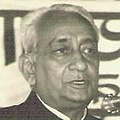# Portrait Name(born – Home state Tenure in office Appointer From To Time in office 1 Nawab Mehdi Nawaz Jung (1894–1967) Andhra Pradesh 1 May 1 August 5 years, 92 days Rajendra Prasad 2 Nityanand Kanungo (1900–1988) Orissa 1 August 6 December [§] [ α] 2 years, 127 days Sarvepalli Radhakrishnan – Justice P. N. Bhagwati (1921–2017) Gujarat 7 December 26 December 19 days Zakir Husain 3 Shriman Narayan (1912–1974) Madhya Pradesh 26 December 17 March 5 years, 81 days – Justice P. N. Bhagwati (1921–2017) Gujarat 17 March 4 April 18 days V. V. Giri 4 K. K. Viswanathan (1914–1992) Kerala 4 April 13 August 5 years, 131 days 5 Sharda Mukherjee (1919–2007) Maharashtra 14 August 6 August 4 years, 357 days Neelam Sanjiva Reddy 6 Professor K. M. Chandy (1921–1998) Kerala 6 August 26 April [§] [ β] 264 days Zail Singh 7 Braj Kumar Nehru ICS (Retd) Uttar Pradesh 26 April 26 February 1 year, 306 days 8 Ram Krishna Trivedi ICS (Retd) Uttar Pradesh 26 February 2 May 4 years, 65 days 9 Mahipal Shastri (1924–1994) Uttar Pradesh 2 May 20 December [‡] 232 days Ramaswamy Venkataraman 10 Sarup Singh (1917–2003) Haryana 21 December 19 June 2 years, 180 days 11 P. C. Alexander IAS (Retd) Kerala 20 June 20 July 30 days Shankar Dayal Sharma (10) Sarup Singh (1917–2003) Haryana 21 July 1 July 1 year, 345 days 12 Naresh Chandra IAS (Retd) Rajasthan 1 July 1 March 244 days 13 Krishna Pal Singh (1922–1999) Madhya Pradesh 1 March 24 April 2 years, 54 days 14 Justice (Retd) Anshuman Singh (1935–2021) Uttar Pradesh 25 April 16 January [§] [ γ] 266 days K. R. Narayanan – Justice K. G. Balakrishnan (born 1945) Kerala 16 January 18 March 61 days 15 Sunder Singh Bhandari (1921–2005) Rajasthan 18 March 7 May 4 years, 50 days 16 Kailashpati Mishra (1923–2012) Bihar 7 May 12 July [‡] 1 year, 66 days A. P. J. Abdul Kalam 17 Balram Jakhar (1923–2016) Punjab 12 July 24 July 12 days 18 Nawal Kishore Sharma (1925–2012) Rajasthan 24 July 29 July 5 years, 5 days 19 S. C. Jamir (born 1931) Nagaland 30 July 26 November 119 days Pratibha Patil 20 Kamla Beniwal (1927–2024) Rajasthan 27 November 6 July [§] [ δ] 4 years, 221 days 21 Margaret Alva (born 1942) Karnataka 7 July 15 July 8 days Pranab Mukherjee 22 Om Prakash Kohli (1935–2023) National Capital Territory of Delhi 16 July 21 July 5 years, 5 days 23 Acharya Dev Vrat (born 1959) Haryana 22 July Incumbent 6 years, 131 days Ram Nath Kovind 






























